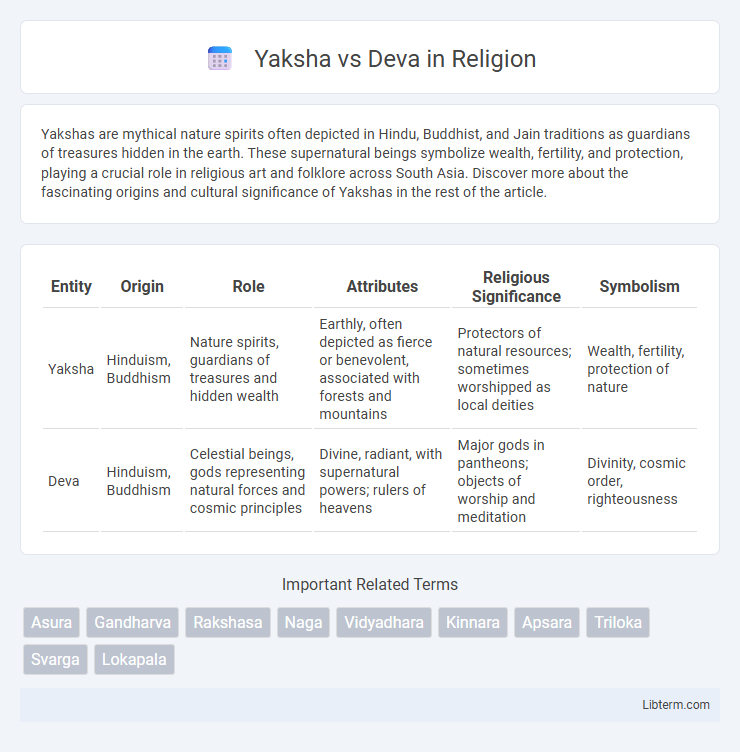Yakshas are mythical nature spirits often depicted in Hindu, Buddhist, and Jain traditions as guardians of treasures hidden in the earth. These supernatural beings symbolize wealth, fertility, and protection, playing a crucial role in religious art and folklore across South Asia. Discover more about the fascinating origins and cultural significance of Yakshas in the rest of the article.
Table of Comparison
| Entity | Origin | Role | Attributes | Religious Significance | Symbolism |
|---|---|---|---|---|---|
| Yaksha | Hinduism, Buddhism | Nature spirits, guardians of treasures and hidden wealth | Earthly, often depicted as fierce or benevolent, associated with forests and mountains | Protectors of natural resources; sometimes worshipped as local deities | Wealth, fertility, protection of nature |
| Deva | Hinduism, Buddhism | Celestial beings, gods representing natural forces and cosmic principles | Divine, radiant, with supernatural powers; rulers of heavens | Major gods in pantheons; objects of worship and meditation | Divinity, cosmic order, righteousness |
Introduction to Yaksha and Deva Mythologies
Yakshas are nature-spirits in Hindu, Buddhist, and Jain mythologies, often depicted as guardians of treasures hidden in the earth and associated with fertility and wealth. Devas, in contrast, are celestial beings or gods representing various aspects of the cosmos, such as Indra, the king of gods in Hindu mythology, embodying power and moral authority. Both entities play vital roles in ancient Indian religious texts, symbolizing the dual forces of nature and divinity within the cosmic order.
Origins and Historical Background of Yaksha and Deva
Yakshas originate from ancient Indian mythology as nature-spirits associated with fertility, treasures, and wilderness, often depicted as guardians of natural resources in Vedic and Buddhist texts. Devas, in contrast, are celestial beings embodying divine forces and moral order, emerging prominently in Vedic religion as gods of elements like fire, rain, and sky. Both Yakshas and Devas reflect early Indo-Aryan cosmology, with Yakshas symbolizing earthly and chthonic powers while Devas represent the heavenly and cosmic order.
Key Differences Between Yaksha and Deva
Yakshas are nature-spirits often depicted as guardians of treasures hidden in the earth, associated with wealth and fertility, whereas Devas are celestial beings representing divine forces and cosmic order. Yakshas possess a more earthly and sometimes ambiguous moral nature, while Devas embody purity, righteousness, and higher spiritual authority in Hindu and Buddhist cosmology. The key difference lies in their domains and roles: Yakshas are linked to the physical realm and natural resources, whereas Devas govern celestial realms and uphold dharma.
Symbolism and Representation in Hinduism and Buddhism
Yakshas symbolize nature spirits associated with wealth, fertility, and protection, often depicted as fierce or benevolent guardians of treasures in Hinduism and Buddhism. Devas represent celestial beings embodying divine qualities such as light, purity, and cosmic order, serving as protectors of dharma and cosmic harmony. The contrasting symbolism highlights Yakshas' earthly, material guardianship versus Devas' spiritual, heavenly authority within the religious cosmologies.
Roles and Responsibilities: Yaksha vs Deva
Yakshas are nature spirits associated with guarding treasures and natural resources in Hindu and Buddhist mythology, often depicted as protectors of wealth and forest guardians. Devas are celestial beings or gods responsible for maintaining cosmic order, overseeing natural phenomena, and guiding moral and spiritual principles. While Yakshas focus on earthly protection and material abundance, Devas embody divine authority and spiritual governance.
Cultural Depictions and Artistic Expressions
Yakshas and Devas appear prominently in South Asian art, with Yakshas typically depicted as robust, guardian figures symbolizing earth's wealth, often carved in ancient Buddhist and Hindu temple reliefs. Devas embody celestial beauty and divine authority, portrayed with radiant halos and serene expressions in classical sculptures and paintings reflecting Hindu and Buddhist cosmology. Artistic expressions emphasize Yakshas' protective and earthly roles juxtaposed against the Devas' ethereal and spiritual qualities, highlighting their complementary roles in mythological narratives and religious iconography.
Powers, Abilities, and Supernatural Traits
Yakshas possess formidable strength and mastery over nature, often controlling forests, treasures, and hidden wealth with supernatural stealth and agility. Devas wield divine powers linked to cosmic forces, exhibiting abilities such as flight, shape-shifting, and control over elements like fire, water, and wind, symbolizing their role as celestial guardians. Both entities display supernatural traits, but Yakshas are typically earth-bound protectors emphasizing physical prowess and mystical secrecy, while Devas possess elevated spiritual energy and celestial authority.
Yaksha and Deva in Ancient Texts and Scriptures
Yakshas and Devas are prominent supernatural beings in ancient Hindu, Buddhist, and Jain texts, where Devas are depicted as benevolent gods associated with cosmic order and righteousness, often residing in heavenly realms like Svarga. Yakshas, in contrast, are portrayed as nature spirits or guardians of treasures, frequently linked with earthly elements and sometimes depicted with ambiguous or protective roles in scriptures such as the Mahabharata, Ramayana, and Puranas. These texts emphasize the Devas' divine authority and celestial duties, while Yakshas appear as powerful but more localized entities, reflecting the complex interplay between divine hierarchy and nature worship in ancient Indian cosmology.
Influence on Folklore and Popular Culture
Yakshas are depicted in South Asian folklore as mystical nature spirits often associated with wealth and fertility, influencing numerous local legends and traditional art forms. Devas, revered as celestial beings and gods in Hindu and Buddhist traditions, play a central role in religious festivals, temple iconography, and spiritual narratives that shape popular culture across India and Southeast Asia. The contrasting portrayals of Yakshas as earthly guardians and Devas as divine entities have enriched mythologies, inspiring literature, dance, and cinema with themes of cosmic balance and moral dualism.
Conclusion: The Enduring Legacy of Yaksha and Deva
Yaksha and Deva represent profound archetypes in ancient mythology, symbolizing the balance between nature's guardians and celestial beings. Their enduring legacy is evident in religious rituals, art, and cultural narratives across South Asia, highlighting a persistent reverence for supernatural protectors and divine forces. Modern interpretations continue to explore their roles in spirituality and folklore, emphasizing the timeless human quest for harmony between earthly and heavenly realms.
Yaksha Infographic

 libterm.com
libterm.com